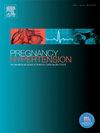妊娠高血压疾病中Lambert Eaton综合征的管理:文献综述
IF 2.9
4区 医学
Q2 OBSTETRICS & GYNECOLOGY
Pregnancy Hypertension-An International Journal of Womens Cardiovascular Health
Pub Date : 2025-09-13
DOI:10.1016/j.preghy.2025.101255
引用次数: 0
摘要
目的回顾有关妊娠期Lambert Eaton Myasthenic Syndrome (LEMS)治疗的文献,重点关注合并高血压疾病(包括先兆子痫和常规使用硫酸镁预防癫痫发作)所带来的临床挑战。数据来源对PubMed、Embase、Web of Science和Scopus进行了系统检索,检索时间截止到2024年5月,检索的关键词和MeSH术语包括“Lambert Eaton Myasthenic Syndrome”、“LEMS”、“妊娠”、“先兆子痫”、“硫酸镁”和“妊娠高血压疾病”。研究入选标准:研究报告了LEMS或相关肌无力综合征患者的妊娠结局、产妇并发症或管理考虑。排除标准包括非英语出版物、动物研究和没有病例级数据的综述文章。研究评价和综合方法研究基于妊娠期Lambert-Eaton肌无力综合征的相关性进行评价,特别关注高血压并发症和癫痫预防策略。由于这种情况的罕见性,纳入的文章主要是病例报告和病例系列。采用定性叙述方法综合数据,重点关注临床表现、干预措施和孕产妇-新生儿结局。考虑到重叠的神经肌肉风险,涉及重症肌无力的研究也进行了回顾以进行比较。由于异质性和样本量有限,未进行正式的偏倚风险评估或统计汇总。结果共收录文献24篇,包括病例报告、病例系列和回顾性分析。其中,5例(21%)特别涉及妊娠期LEMS, 2例(8%)报告了新生儿短暂性LEMS。3项(13%)研究讨论了硫酸镁,其中至少有一例记录了神经肌肉症状的恶化。两个病例涉及先兆子痫和LEMS的共同发生,突出了平衡癫痫发作预防与神经肌肉安全的困境。没有确定标准化的治疗方案。报告强调多学科护理和个性化决策。结论LEMS与妊娠期高血压疾病的交叉关系在临床上较为复杂且报道不足。硫酸镁的使用——子痫前期治疗的基石——对LEMS患者有潜在的风险,强调了提高认识、个性化治疗计划和多学科合作的必要性。需要进一步的研究来建立安全的、基于证据的指南来管理这一罕见但高风险的患者群体。本文章由计算机程序翻译,如有差异,请以英文原文为准。
The management of Lambert Eaton syndrome in the setting of hypertensive disorders of pregnancy: A literature review
Objective
To review the literature regarding the management of Lambert Eaton Myasthenic Syndrome (LEMS) in pregnancy, with a focus on the clinical challenges posed by coexisting hypertensive disorders, including preeclampsia and the routine use of magnesium sulfate for seizure prophylaxis.
Data sources
A systematic search of PubMed, Embase, Web of Science, and Scopus was conducted through May 2024 using combinations of keywords and MeSH terms including “Lambert Eaton Myasthenic Syndrome,” “LEMS,” “pregnancy,” “preeclampsia,” “magnesium sulfate,” and “hypertensive disorders of pregnancy.”
Study eligibility criteria
Studies were included if they reported pregnancy outcomes, maternal complications, or management considerations in patients with LEMS or related myasthenic syndromes. Exclusion criteria included non-English language publications, animal studies, and review articles without case-level data.
Study appraisal and synthesis methods
Studies were appraised based on relevance to Lambert-Eaton Myasthenic Syndrome in pregnancy, with particular attention to hypertensive complications and seizure prophylaxis strategies. Due to the rarity of this condition, included articles were primarily case reports and case series. Data were synthesized using a qualitative narrative approach, focusing on clinical presentation, interventions, and maternal-neonatal outcomes. Studies involving myasthenia gravis were also reviewed for comparison, given overlapping neuromuscular risks. No formal risk-of-bias assessment or statistical pooling was conducted due to heterogeneity and limited sample size.
Results
Twenty-four citations were included, encompassing case reports, case series, and retrospective analyses. Of these, 5 (21%) specifically involved LEMS during pregnancy, and 2 (8%) reported transient neonatal LEMS. Magnesium sulfate was discussed in 3 (13%) studies, with at least one case documenting exacerbation of neuromuscular symptoms. Two cases involved the co-occurrence of preeclampsia and LEMS, highlighting the dilemma of balancing seizure prophylaxis with neuromuscular safety. No standardized treatment protocols were identified. Multidisciplinary care and individualized decision-making were emphasized across reports.
Conclusions
The intersection of LEMS and hypertensive disorders of pregnancy is clinically complex and underreported. The use of magnesium sulfate—a cornerstone of preeclampsia management—poses a potential risk for patients with LEMS, underscoring the need for heightened awareness, individualized treatment plans, and multidisciplinary collaboration. Further research is needed to establish safe, evidence-based guidelines for managing this rare but high-risk patient population.
求助全文
通过发布文献求助,成功后即可免费获取论文全文。
去求助
来源期刊

Pregnancy Hypertension-An International Journal of Womens Cardiovascular Health
OBSTETRICS & GYNECOLOGYPERIPHERAL VASCULAR-PERIPHERAL VASCULAR DISEASE
CiteScore
4.90
自引率
0.00%
发文量
127
期刊介绍:
Pregnancy Hypertension: An International Journal of Women''s Cardiovascular Health aims to stimulate research in the field of hypertension in pregnancy, disseminate the useful results of such research, and advance education in the field.
We publish articles pertaining to human and animal blood pressure during gestation, hypertension during gestation including physiology of circulatory control, pathophysiology, methodology, therapy or any other material relevant to the relationship between elevated blood pressure and pregnancy. The subtitle reflects the wider aspects of studying hypertension in pregnancy thus we also publish articles on in utero programming, nutrition, long term effects of hypertension in pregnancy on cardiovascular health and other research that helps our understanding of the etiology or consequences of hypertension in pregnancy. Case reports are not published unless of exceptional/outstanding importance to the field.
 求助内容:
求助内容: 应助结果提醒方式:
应助结果提醒方式:


